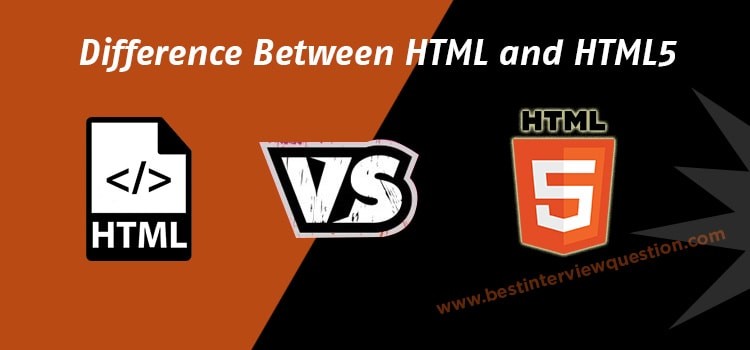Difference between html and html5

Developed in the year 1989 by Tim Berners-Lee, HTML an Internet-based hypertext system, took the industry with its easy to use features. It is the reason why it has become a hot topic, and there is a rise in HTML interview questions and answers for experienced. Also, in the year 1990, the browser and server software was specified.
Let us know some key features about HTML and then compare HTML and HTML 5. Two main differences between HTML and HTML5 are that the former uses cookies for temporarily storing the data and another uses application cache and SQL databases for storing offline data. No drag and drop effects are there in HTML, but in HTML 5 you can use those effects.
To know more points of difference between the two, stay tuned.
HTML 5
It is the fifth version of the hypertext system released in the year 2014. There is a rise in the updating versions of the system to make the internet more accessible for the common man. There are various tricky HTML5 Interview Questions. All the browsers support every feature of HTML5. W3C has recommended the use of HTML5 since 2012.
Features of HTML5 over the older versions
- Supports the incorporation of audio and video in the language.
- Includes detailed parsing rules, processing models, canvas for drawing, support for local storage.
- Supports JavaScript API, such as cross-platform mobile application, Geolocation API for identifying the location.
HTML
Full form of HTML is HyperText Markup Language. This Internet-based hypertext system is a method that can be used with the help of hyperlinks opening the next pages by moving around the web. In the definition, Markup is the HTML tags that contain text within them for putting images, hyperlinks, formatting the text. The examples of the tags are opening and closing tags.
Features of HTML
- Considered to be the building blocks for the World Wide Web and is the major part of the front-end code of every website.
- Codes are not displayed on the website but still, play an essential role.
- Less mobile friendly.
Comparison between HTML and HTML5 defined in easy words
| Parameter | HTML | HTML 5 |
|---|---|---|
| Definition | It is an acronym for Hypertext Markup Language | It is the updated version of HTML with added functionalities for internet technology-interaction for content presentation and structuring |
| Geographical Support | Locations of the user visiting the website support this hypertext system. The difficulty level of finding the user location is high | It is easier to find user location due to JavaScript Geolocation API |
| Multimedia Support | No support for audio and video language | Integration of audio and video in HTML5 is there, and many students make the mistake of neglecting this feature. |
| Storage | The temporary storage place is a browser cache | Application cache, web storage, SQL database are available for temporary storage in HTML5. For the storage purpose, we can use the JS API. |
| Browser Compatibility | There is high compatibility with all the browsers, but there is a need for some modifications for supporting HTML characteristics | There are addition and removal of elements, new tags, and many more. Therefore, only a few of the browsers support HTML5 |
| Communication | Streaming and long pooling are the processes of the interaction of client and server as there is no socket support | Web sockets support HTML5 allowing full duplex communication between client and server. |
| Graphics Support | Graphics Support is there in HTML due to the availability of the tools such as Adobe Flash, VML, SilverLight, etc. | There is no need for any tools for the Graphics Support; it is available by default with the help of SVG and canvas |
